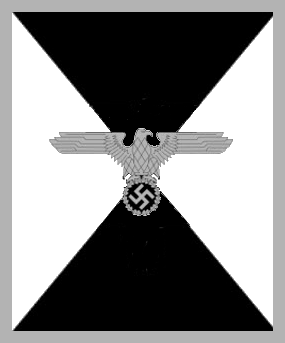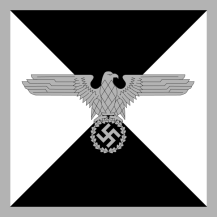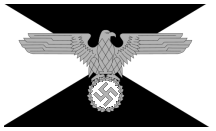 Image by Pete Loeser (based on original photo from Jody Williams), 18 May 2018
Image by Pete Loeser (based on original photo from Jody Williams), 18 May 2018
Last modified: 2025-01-11 by pete loeser
Keywords: nsdap |
Links: FOTW homepage |
search |
disclaimer and copyright |
write us |
mirrors
[Editorial Note: The Letters SS mean "Protection Guard (Squadron)" - thus Waffen-SS would translate as "Armed Protection Guard" and Allgemeinen SS as "Universal (Common or General) Protection Guard."]
A new publication in 2013 by Andreas Herzfeld, a member of the German Flag Society, is called Die Rimann'sche Sammlung deutscher Autoflaggen und Kfz-Stander (The Rimann-Collection of German car flags and vehicle standards). Volume 1 deals with standards used until 1945. Mr. Rimann died a few years ago. He had the most comprehensive collection of Vehicle standards that were used in Germany from the "beginning" to the present. He was said to possess a "complete" collection of images and official regulations as to the standards. Andreas Herzfeld, the author of the book, "inherited" the collection and published it this year.
In the book it says the most of command flags for the Amtschefs der Hauptämter der Allgemeinen SS (Chiefs of the Main Offices of the Universal Protection Squadron) were introduced on December, 1, 1936. (SS-DV Nr. 25 vom 15.09.1936). The structure of the SS at first included three Hauptämter (offices) in all.
 Image by Fornax
Image by Fornax
A square flag with the field diagonally divided into four fields, top and bottom black, left and right white. Superimposed at the center a silver party eagle (with wreath and swastika). The flag was reported to have a silver border.
Pete Loeser, 24 March 2013
 Image by Pete Loeser (based on original photo from Jody Williams), 18 May 2018
Image by Pete Loeser (based on original photo from Jody Williams), 18 May 2018
This apparent rectangular variant of the SS Command Flag of the National Leader is either a wall hanging or a parade standard. The reverse side is solid black and has looped black fabric at the top to form a closed cloth tunnel that extends the full width of the flag. This indicates it was designed to hang from a wooden cross bar hung from the top of a flag staff or pole; typical of parade standards carried in NSDAP party ceremonies.
Pete Loeser, 18 May 2018
![[SS National Leader (NSDAP, Germany)]](../images/d/de_ss-rf.gif) 1:1
1:1
![[SS National Leader (NSDAP, Germany)]](../images/d/de_rfss.gif) 1:1 Images by Jaume Ollé
1:1 Images by Jaume Ollé
These interpretations of the Command Flag of the SS National Leader by Jaume Ollé show a narrow white or red border instead of silver. They are presently undocumented and questionable.
Pete Loeser, 24 March 2013
The Chef of a SS-Hauptamt used a 20x35 cm sized flag. It was black and white diagonally divided and surrounded by a silver colored stripe. In the center there was the SS-eagle in silver. It is reported to have a silver border.
Pete Loeser, 24 March 2013
![[Chief of a SS Main Office (NSDAP, Germany)]](../images/d/de_ss-ht.gif) 3:5 Image by Jaume Ollé
3:5 Image by Jaume Ollé
with reported white border
![[Chief of a SS Main Office flagphoto)]](../images/d/de}ns^ss.jpg) Image sent by Rachael Madden, 21 Jun 2009
Image sent by Rachael Madden, 21 Jun 2009
I have a Nazi flag from World War Two which I do not know what it is. The eagle's feet are standing on top of a swastika which is embroidered inside of a circle of leaves. The colors are black with gray and the background color is like a tan fabric.
Rachael Madden, 21 Jun 2009
This may be useful for redrawing of it. In particular, the inside of the wreath appears to be white (not black as we show).
Rob Raeside, 22 Jun 2009
I am not 100% sure if the photography does show an original from the era. It's just a gut feeling, but the eagle does not look correct to me.
M. Schmöger, 22 Jun 2009
This flag is very strange. It appears to be a flag for a Chef eines SS-Hauptamtes, but there are some problems. The swastika on the white disk was indeed used, but not in connection with the SS-eagle that is shown here! The first flag of a Chef eines SS-Hauptamtes was introduced in June 1935. The eagle used is different, it was the old fashion one (already introduced in 1933). The actual flag was only used between June 1935 and December 1936, when the new regulations were instituted. The border of this original flag was silver, not white, and the eagle, as already mentioned, is obviously different. So I'm unsure what the flag in this photo represents. It appears to me to perhaps be a replica, rather than an original. I guess it could be "remotely" possible that this was a transition version, i.e. - new eagle, but old swastika-field and border of white, made perhaps because a flag manufacturer wasn't sure about the official regulations, but this is a bit of a stretch. All I can say is the flag shown in the photo is a version that was not officially recognized or documented in any reliable source to my knowledge.
Pete Loeser, 25 March 2013
 Speculative image drawn by Pete Loeser
Speculative image drawn by Pete Loeser
with white background on swastika and white border added (based on photo above)
The title of Assistant or Department Chief (Amtschef) was held by countless SS officers and sub-department heads. These Amtschefs of the SS-Hauptamt (Assistant Chief of a SS Office) used a 20x35 cm sized flag. It was divided black and white into four rectangles. It was surrounded by a small outer black and inner white stripe. In the upper left corner of the flag there was the SS-eagle in silver.
Pete Loeser, 24 March 2013
![[Chief of a SS Office (Inpector)]](../images/d/de}ss-ht4.gif) Image by Fornax and Pete Loeser
Image by Fornax and Pete Loeser
The Amtschefs were also inspectors on the personal staff of the Reichsführer SS (National Leader of the Protection Squadron). When acting as such they were allowed to use a different flag. (Regulation issued on July, 25 1937) It was 20x35 cm, and was almost the same as the flag for the Chef des Hauptamtes. But instead of a silver border the flag was surrounded by a black border. The black border was disconnected by a very small white border from the inner black triangle.
Pete Loeser, 24 March 2013
 Image by Peter Hans van den Muijzenberg and Pete Loeser
Image by Peter Hans van den Muijzenberg and Pete Loeser
There was only a single SS-vehicle flag that used black SS-runes in the corner and this was the flag for a Befehlshaber der Waffen-SS (Commander of the armed SS). This 20x35 cm sized flag was introduced in April or May 1942 as an addition of the SSDV Nr. 25 (VBl Waffen-SS 3. Jg. Nr. 12 vom 15.06.1942). In Die Rimann'sche Sammlung deutscher Autoflaggen und Kfz-Stander (The Rimann-Collection of German car flags and vehicle standards), Andreas Herzfeld does not mention any specific data as to the width of stripes or anything else in this kind (in other cases he gives these details), so it is likely that the original SS-regulation did not say anything about it, but only displays the image. So it might be understandable that in the course of the war there were variations as to details of the flag.
Pete Loeser, 24 March 2013
And that image shows an 336x202 image that has a wide black outer edge and a narrow white inner edge. Assuming that this is Andreas' image, I wonder about the different ratio; the image is close to 20:33, rather than the 20:35 that follows from the measurements the text gives. Is this a problem with the original regulation?
It's also not the same ratio as the apparently 2:3 of Jeff's photograph. Plus, it has a wide outer black border and a narrow white inner border, whereas the flag in the museum, that Jeff unfortunately doesn't name, has the inner white border wide, and the outer black narrow. The narrow white border is indeed a far more likely design, but so far all we have is the photograph of the actual flag, and that has a wide white border.
Even if we can get Andreas´ confirmation that the image and the measures are from the original regulation, and we could match that image correctly, and maybe the text as well, in my opinion, we'd still have to cover the design of the only specimen we currently know to actually exist. (I've asked Jeff if he recalls what museum holds it.)
Peter Hans van den Muijzenberg, 10 September 2013
 Attachment from Andreas Herzfeld, 22 September 2013
Attachment from Andreas Herzfeld, 22 September 2013
I cannot understand this never ending discussion. It is so easy to ask me. Every time I indicate my sources and every one can check the given information.
1. In the attached document you'll find the regulation for the flag for a Commander-in-Chief of Armed SS (this is the correct rank translation).
2. The given measures are correct.
3. The relation to SS-Dv. Nr. 25 as an amendment of it is correct (This
was another discussion).
4. If a picture in a book has an incorrect ratio, this is not an problem, because there exists different printing, drawing and transformation mistakes, that you see only after publishing. The important thing is the ratio given in the text.
5. In the regulation is given only a picture, as you can see, and no date of introduction.
6. In reality, some real flags are different from the regulations, and those captured and stolen in Germany can be originals or fakes.
Andreas Herzfeld, 22 September 2013
The SS-Abschnitt (Protection Guard District) were formed in the early 1930s to replace the SS-Brigades. The function and operation of the Abschnitt's was essentially the same as with the Oberabschnitts (Upper section), but the units were usually commanded by an SS-Brigadeführer (Brigade Leader) or Oberführer (Top Guide). Abschnitt's were given Roman numerals and names. These units generally performed Police duties during the war.
Pete Loeser, 26 March 2013
A SS leader placed in charge of a political section would use this car flag to indicate their presence in an official vehicle.
Pete Loeser, 26 March 2013
 Image by Pete Loeser (based on original photo from Jody Williams), 18 May 2018
Image by Pete Loeser (based on original photo from Jody Williams), 18 May 2018
An apparent variant of the SS Section Command Flag (70cm x 40cm) was produced with the eagle facing the hoist on both sides.
Pete Loeser, 18 May 2018
The SS-Standarte (Protection Guard Regiment) was the most important unit of the Allgemeinen SS (Universal Protection Guard). The Standarte name came from the term for a "Regimental Standard." Each Standarte had its own number, but also had names based on either a location, a popular nickname, or the name of a Nazi hero. The standard rank for the Standarte Leader was equivalent to an army Colonel and called a Standartenführer (Standard's guide).
Pete Loeser, 26 March 2013
A SS-Sturm (Protection Guard Company) was the lowest organizational level of the Allgemeinen SS (Universal Protection Guard) and the most common unit in which an average SS member would serve in. Company commanders usually rated a rank equivalent to an army Lieutenant (Untersturmführer) or an army Captain (Hauptsturmführer).
Pete Loeser, 26 March 2013
The Allgemeine-SS also had several cavalry commands intended to appeal to German aristocrats. These were basically equestrian riding clubs that basically ceased to exist after World War II began. There were nine SS-Cavalry Districts (SS-Reiterabschnitt) established and twenty-four cavalry regiments (SS-Reiterstandarte) formed in the Allgemeine-SS. These units had a special crossed lances insignia on their Unit Standards which also displayed their Standarten number.
Pete Loeser, 26 March 2013
The Fördernde Mitglieder (SS-FM) was an organisation for non-SS who supported the SS financially.
Marcus Wendel, 1999